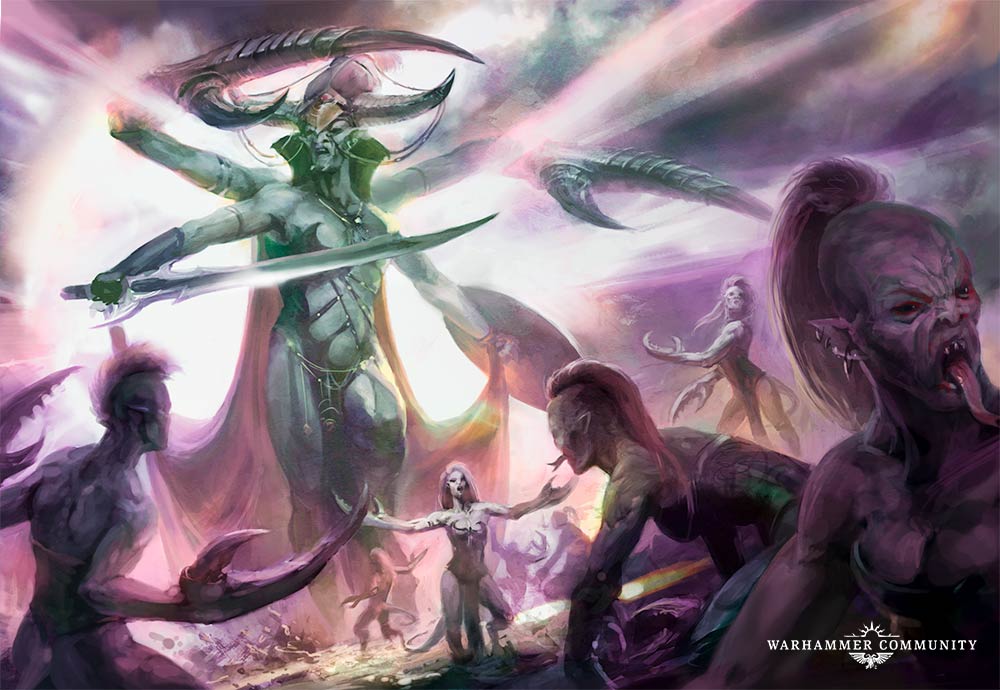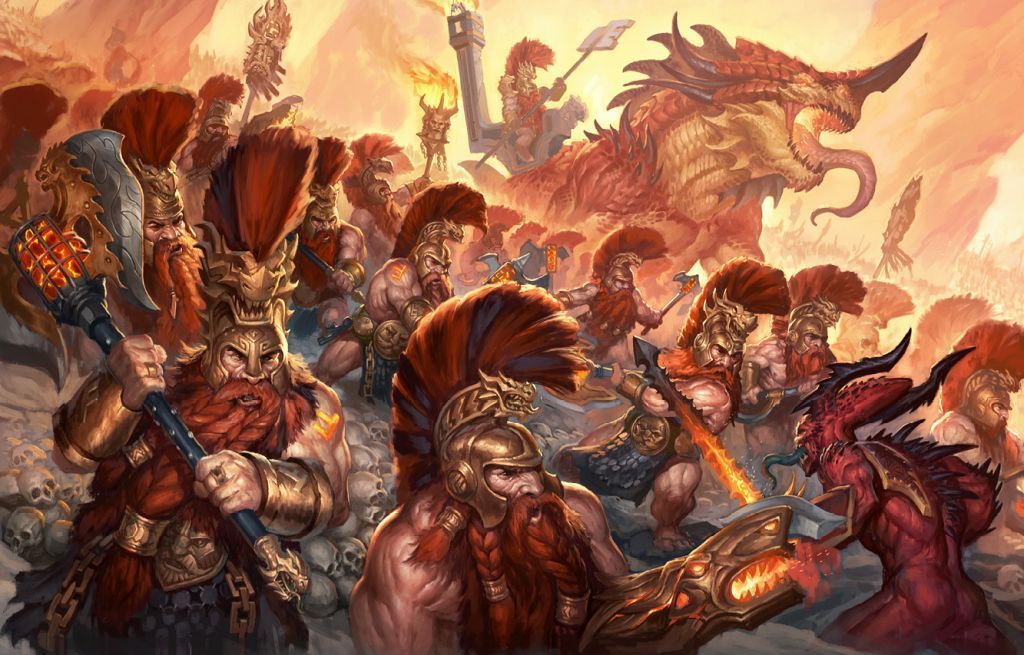Today is a follow up in the NicoLab series on rules issues in Warhammer Age of Sigmar – the Activation Wars Part Two. You can check out the original article, where Nico dissects the rules of sequencing, activation and combat in Age of Sigmar. Feel free to drop a comment at the end of the article with your thoughts, reasoning and ideas for future articles in this series.
And, as always, check out Dark Fantastic Mills for great 3D printed terrain perfect for wargaming. Its super versatile and light so worldwide shipping is inexpensive. Use the “aos shorts” discount code for a further 10% off the already decent prices.

Of the six new Battletomes since the original article, some have brought new tools for the Activation Wars. The Arms Race continues with the emergence of clear winners and losers.
Slaanesh’s impact on the activation wars
The first article was being edited as the Fyreslayers and Slaanesh books were dropping. In that first article, I noted that the special rule in the final paragraph of Locus of Diversion (now called the Slaanesh Proviso) would be “very interesting” and so it has proven:

Slaanesh proved dominant off the back of their excessive summoning and Locus. Now Locus (and Slaanesh in general) are reeling from changes to the dice roll to trigger Locus (and summoning changes). However, the Slaanesh Proviso remains intact, which should keep Slaanesh in the top tier of armies (if no longer dominant).

Recap: phase dependent rules and subphases
We can briefly recap the key principles set out in the previous article. Some have been refined since then by FAQs.
- The Start, During and End parts of a phase are important distinctions which can be likened to discrete subphases.
- Abilities that are used “During” the phase cannot be used in the Start (e.g. Morathi).
- Many abilities (7 or more from both players) can be used in a given Start of a phase.
- The Active Player (the player whose turn it is) does all of its simultaneous abilities in an order of its choice, then the non-active player does all of its simultaneous abilities in an order of its choice.
- The phases and sequencing rules have been interpreted strictly even where this leads to odd results.
- The Slaanesh Proviso (see above).
- The Triggered Exception. During part abilities can be triggered in the Start part of a phase. For example, Savage Strike (Strike First in the Start part) does count as happening in the During part for the sole purpose of triggering other abilities such as Feeding Frenzy (fight again in the combat phase) or No Respite (Blood Warriors’ phase-dependent fight on Death). It’s worth emphasising that the Triggered Exception is a narrow one – this doesn’t allow During abilities to be used in the Start part turn normally.
- Units of the Active Player that Fight Last and move within 3” of enemy units that did not fight earlier in the During part of the combat phase, will make those enemy units eligible to fight in the End of the combat phase. This is not true of units of the non-active player’s units that have been made to Fight Last and then move within 3” of non-activated enemy units. This is because of 4. above – the Active Player has to do all its end of the combat phase abilities first.
- This is a bad ruling that is overly complicated. There should be no eligibility to fight in the End part without a specific ability. Tough luck if you’ve missed your chance. There is no reason to restart the selection of units to activate which was already completed in the During part.
- If there are two contradictory abilities affecting a unit, then the second to be applied takes precedence. The most recent ability trumps.
- This is not a new rule (originating in the Beasts of Chaos FAQ for the Taurus and High Tide), but the December 2019 FAQ has granted it greater prominence. Contradictory abilities could include Strike First and Strike Last but also Strike Last and a triggered ability to Strike (e.g. Smashing & Bashing or Tyrants of Blood). See below:
A more recent Strike Last may not help?
You would think that a Start of the Combat Phase Strike Last would be pretty good right?
The Alvagr Ancient Command trait is triggered in the start of the combat phase and causes enemy units to Strike Last. However, in the Alvagr Ancient player’s turn, he must use Strike Last before the opponent in the start of the combat phase (because Active Player abilities go first). So the opponent can immediately trump this with its own Start of the Combat Phase Strike First (e.g. Hermdar).
On the other hand, in the opponent’s turn, the opponent uses Strike First and… resolves this activation – before the Thundertusk can use Alvagr Ancient. It’s lose-lose.
One sliver of good news is that the Lords of the Lodge fight again ability merely allows the Hermdar unit to be selected to activate for a second time in the combat phase. There’s no hook for it to activate for a second time in the Start of the Combat Phase. Hence, in the Fyreslayer’s turn, the order would be:
- Start of the Combat Phase
- Hermdar (Hearthguard Berzerkers fight)
- Alvagr Ancient Applies to HGB
- Combat Phase
- Other activations alternating order (starting with the Fyreslayers).
- End of Combat Phase
- HGB fight again (Lords of the Lodge)
- Any other End of Combat Phase abilities of the Mawtribes player.
A Hierarchy of Abilities
With full credit to Vince and Tom of Warhammer Weekly fame, here’s a fleshed out list of weapons for the Activation Wars.
- Start of the Battle
- Immortal Champion (S to D)
- Halo of Blood (Khorne)
- Swift as the Wind (Tempest’s Eye)
- Start of the Third Battle Round
- High Tide (Idoneth)
- Hero Phase
- Itchy Nuisance (Gloomspite Gitz)
- Soul Cage (Nighthaunt)
- Binding Damnation (Slaves to Darkness)
- Shooting Phase
- Flinger (Gloomspite Gitz)
- Charge Phase
- Wave of Terror (Nighthaunt) (not subject to the Slaanesh Proviso)
- Savage Strike (FEC)
- Spear of the Hunt (Cities of Sigmar)
- Helm of Many Eyes (Slaves to Darkness)
- End of the Charge Phase
- Locus of Diversion (note the Slaannesh Proviso still applies if this combines with a Strike First ability).
- Start of the Combat Phase
- Hermdar (Fyreslayers)
- Strike Quickly (Hysh)
- Alvagr Ancient (Mawtribes)
- Stomp (Sylvaneth)
- Khartoth the Bloodhunger (Khorne)
- Quicksilver Draught (Stormcast)
- Doppelganger Cloak (Ulgu)
- Halo of Blood (Khorne)
- Combat Phase
- Tyrants of Blood (Khorne) (not subject to the Slaanesh Proviso)
- Smashing & Bashing (not subject to the Slaanesh Proviso)
- Death Frenzy (any time – also not subject to the Slaanesh Proviso)
Abilities towards the bottom of the above hierarchy are less likely to be trumped than those at the top and are more valuable.
What can I do to navigate the Activation Wars?
Generally speaking buffs are stronger than debuffs in the Activation Wars (as the debuffs tend to be earlier in time e.g. spells) or their timing is such that they always get outfoxed by a Start of the Combat Phase Strike First (e.g. Stomp and Alvagr Ancient).
If you’re playing with one of these debuffs, you should check for any Strike First abilities and as the opponent you should volunteer information about these (and discuss how they will interact before deployment).

It’s worth noting that the presence of the word “immediately” in a rule is essentially poetic or decorative language and has no impact on sequencing.
Doppelganger Cloak remains one of the best answers to Slaanesh/Strike First or Fight Last. It’s particularly strong in the Slaanesh player’s turn as Locus will cause the Slaanesh player to be unable to attack at all (as it must resolve all of its End of Combat Phase abilities before the Locused player – see principle 8. above). Against the Doppelganger Cloak, the Slaanesh player is better off not using Locus at all.
Fight on Death is also a reasonable solution to Strike First abilities. For example Plague Monks or StormVermin with Death Frenzy can make positive trades with your opponent. Death Frenzy – like Smashing & Bashing – is a triggered ability, so it will be resolved at that trigger, trumping any Strike Last ability (as it is more recent than the Strike Last ability).
Conclusion
With the proliferation of Strike First and Strike Last abilities out there, the Activation Wars are still going strong. However, the rise of Ossiarch Bonereapers shows that there are alternatives. Despite having almost no Activation Wars tricks of their own (only a lesser quality 6” pile in on the Kavalos Death Riders); and Mortek Guard losing their re-roll saves against Strike First, Ossiarch Bonereapers remain competitive through sheer efficiency and astute resource management.
The absence of the expected nerf to the Soulscream Bridge also encourages heavy shooting lists like Hallowheart or Tempest’s Eye (particularly those that benefit from not moving by being setup instead). Kharadron Overlords and Tzeentch also loom large on the scene! All to play for!



Leave a Reply
You must be logged in to post a comment.